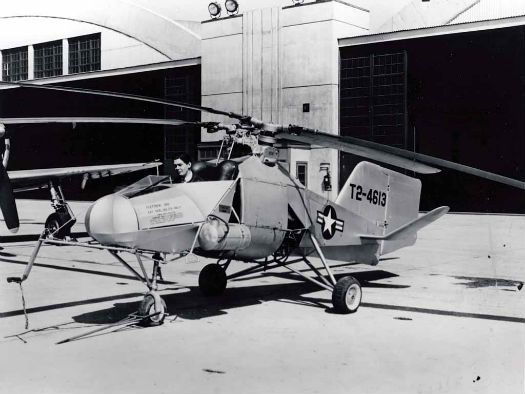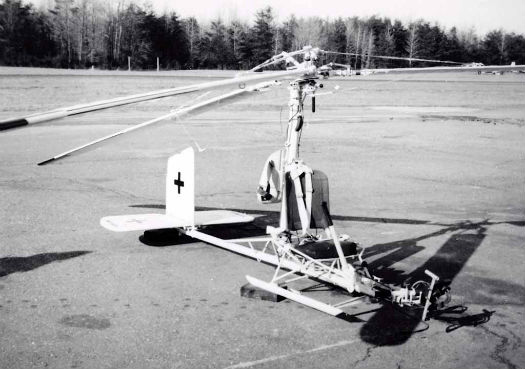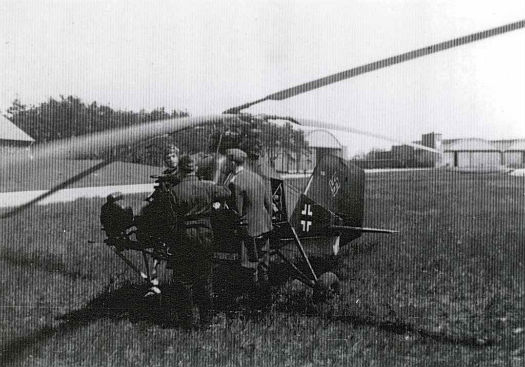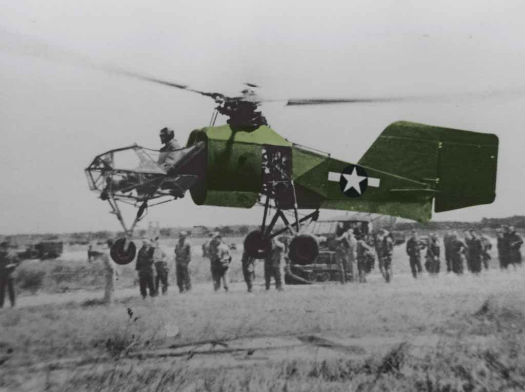
A U.S.-captured Flettner Fl 282 helicopter in flight somewhere in Germany prior to being shipped to the U.S. for evaluation and testing. Only one of the type appears to have survived to the present day, and that is in poor condition in a museum in England. Jeff Evans Collection Photo
As the Third Reich fell in Germany on May 8, 1945, there began a little known race among the Allies to take advantage of the defeated country’s aeronautical technological breakthroughs. Germany had been on the cutting edge of aviation for over a decade, through the development of jet aircraft, rocket technology — and even successful helicopter flight. Instrumental in the progress and evolution of a controllable flying helicopter were aeronautical engineers Henrich Focke and Anton Flettner.
It just so happened that the major German helicopter developments were concentrated in and near the area occupied by the U.S. forces — including the world’s first helicopter squadron, Transportstaffel 40, based at Ainring in southern Germany. On May 9, three of the squadron’s helicopters (two Focke-Achgelis Fa 223s and a Flettner Fl 282) were turned over to U.S. forces, and plans were made to ship the helicopters back to the U.S. for evaluation and testing (along with another Fl 282 that Anton Flettner surrendered to Americans at Bad Tölz). Eventually, several other types were turned over to the U.S. Army, including Fa 330 autogyros and a rare Doblhoff WN 342 jet helicopter in Zell am See, Austria.
Between June 18 and July 14, 1945, Richard Prewitt, a rotary-wing engineer from Kellett Aircraft Corp., made a 300-mile (483-kilometer) trip through southern Germany as a technical representative of the U.S. Army Air Forces to fully investigate the Germans’ wartime helicopter developments. Bartram Kelley from Bell Aircraft Corp. also conducted interviews, and the pair prepared reports on the Fl 282, the Fa 223 and Focke Fa 330, Doblhoff helicopters, and explored the history of the remarkable German rotary-wing program.

A restored Fl 282 helicopter in the U.S. around 1947. The final fate of the aircraft is unknown. Jeff Evans Collection Photo
Germany’s Rotary-wing past
The credit for much of the German rotorcraft industry’s development lay with Henrich Focke. Together with Georg Wulf, Focke founded the Focke-Wulf aircraft company in 1923. In its early years, Focke-Wulf developed several commercially unsuccessful fixed-wing aircraft (Wulf was killed while flight testing during this period), before producing the popular Fw 44 Stieglitz in 1934. During this time, Focke had also purchased a license to build autogyros from the Cierva Autogyro Company, and created over 30 of the aircraft. This experience helped him in the development of his own helicopter — the Fw 61.
The Fw 61, powered by a 160-horsepower (h.p.) Siemens-Halske Sh 14 radial engine, had a single-seat design, with counter-rotating twin rotors set on outriggers on either side of the fuselage. The first fully controllable helicopter, it was capable of flying forwards, sideways, and backwards — and was able to hover. It took its first tethered flight in June 1936, and in May 1937, carried out one of the world’s first autorotational landings, from a height of 1,130 feet (344 meters). Two months later, the Fw 61 broke helicopter records when it flew at 76 mph (122 km/h) to reach an altitude of 11,243 feet (3,426 meters), and flew non-stop for 143 miles (230 kilometers).
The Fw 61 garnered great publicity when Hannah Reitsch, a young female test pilot, flew the aircraft inside the Deutschlandhalle sports arena in Berlin in 1938, and U.S. aviation pioneer Charles Lindbergh was even given a demonstration of its capabilities during a pre-war visit to the country. Helicopter development soared in Germany at this time — and across the Atlantic, funding was released for U.S. helicopter development. Unfortunately, neither of the two Fw 61s produced would survive the war.

The Focke-Wulf Fw 61 during an early test flight. The small propeller at the front was used to cool the engine. The aircraft first flew while tethered on June 26, 1936, prior to the start of World War II. Jeff Evans Collection Photo
Focke’s success with the Fw 61 led to a German air ministry contract with his new company, Focke-Achgelis, for a larger military version of the helicopter in 1939. The aircraft was originally known as the Fa 266 Hornisse (hornet), but was re-designated as the Fa 223 Drache (dragon) before its first flight in August 1940.
The Fa 223 had two rotors — each with three 39-foot (12 meter) blades — that were mounted on outriggers, much like the Fw 61. Powered by a 1,000-h.p. BMW Bramo 323 radial engine, the helicopter could carry up to six passengers. The Fa 223 cruised at 83 mph (134 km/h), set a new altitude record of 23,294 feet (7,181 meters), and was able to sling loads close to 2,000 pounds (907 kilograms). Mountain tests were conducted using the Fa 223 during September 1944, with the goal being to replace the truck for mountain transport. Allied bombers destroyed numerous Fa 223 helicopters in June 1942 at its production factory, near Bremen. Three prototypes and 17 production models were manufactured by the end of the war.
Focke also developed a small unpowered rotor kite called the Fa 330 Bachstelze (wagtail) for the German Navy. The aircraft was towed by surfaced submarines and used for the observation of enemy aircraft and convoys while at sea. The compact single-place aircraft, which had a 24-foot (7.3-meter) three-bladed rotor, could be assembled in minutes, and flew up to a height of 500 feet (152 meters). The pilot communicated with the U-boat below by telephone — the line running down the tow cable. The Fa 330 was normally winched back down to the submarine; however, in an emergency, the autogyro cable could be cut and the pilot could parachute to safety as the aircraft fell into the ocean.
The Fa 330 autogyros were placed in service during 1942, and around 200 were manufactured in total. Some were used in the Indian Ocean, while a few also went to Japan. However, the aircraft saw very limited use in actual wartime operations.

The Fa 330 rotor kite autogyro was used off German submarines for observation. Around 200 Fa 330s were built during the war. Jeff Evans Collection Photo
Intermeshing production
Another driving force in the early German helicopter industry was Anton Flettner, a gifted engineer who built his first autogyro and helicopter during the 1930s. In 1937, he designed the Fl 265 — a helicopter that had two counter-rotating intermeshing rotor blades that were driven by a central gear-box. An Fl 265 was used for sea trials off a German Navy cruiser with great success. By late 1939, the agile Fl 265 convinced the German Air Ministry to give Flettner a contract for an improved two-seat version — which would become known as the Fl 282 Kolibri (hummingbird).
The first flight of the Fl 282 is believed to have taken place in the fall of 1941, and the aircraft turned out to be a very stable and highly maneuverable helicopter. The Fl 282 had a 160-h.p. Siemens-Halske Sh 314E radial engine located in the center fuselage, and two intermeshing counter-rotating blades. In terms of performance, the Fl 282 cruised at 71 mph (114 km/h), had a gross weight of 2,205 pounds (1,000 kilograms), and a service ceiling of 13,450 feet (4,100 meters).
The Fl 282 is believed to be the first production helicopter program in the world. There were 25 of the aircraft built by the war’s end, with Allied bombing helping to curtail production. It flew more than any other German helicopter during the war, and over 50 pilots were trained on the helicopter.

A Doblhoff WHN 342 jet helicopter prior to transportation to the U.S. Only tethered flights were completed at Wright Field in Ohio. Jeff Evans Collection Photo
Utilizing the Technology
In July 1945, the U.S. aircraft carrier HMS Reaper (on loan to the British during the war) left Europe for New Jersey, loaded down with aircraft spoils of war. Mixed in with Luftwaffe jets and other fixed-wing aircraft were two Fl 282s, the Doblhoff helicopter, and numerous Fa 330s.
After their arrival in the U.S., the helicopters were transported to the Air Force facility at Freeman Field, near Seymour, Ind., to be made airworthy. They were then sent to the Army Air Force at Wright Field in Ohio.
One of the original Fl 282s was damaged while flying at Freeman Field, and was then used to keep the remaining Kolibri airworthy. The Prewitt Aircraft Company of Wallingford, Pa., received a contract in February 1947 to conduct a flight test program on the Fl 282, studying stability, performance, hovering efficiency, and flight vibrations. The evaluation took several months, and the pilot, Dave Driskill, recorded 20 hours of flight in the aircraft, reporting it to be stable, responsive and simple to fly.
While no one knows the final resting place of the aircraft, an Fl 282 rotor head and transmission assembly was recently located at in a storage area at the National Air and Space Museum in Washington, D.C. Interestingly, it doesn’t appear to have been part of either of the two Fl 282s that came to the U.S. after the war.

A German Flettner Fl 282 helicopter being prepared for flight during the war. Some were capable of carrying one to two passengers in the back of the helicopter. Jeff Evans Collection Photo
The Doblhoff WN 342 helicopter was tested while tethered to the ground at Wright Field during 1946. It went to the General Electric Company in Schenectady, N.Y., for further testing in the late 1940s. The helicopter’s fate is unknown.
As for the Fa 330 rotor kites, three went to Freeman Field in 1946, and two were shipped to Wright Field. In August 1948, the newly-formed U.S. Air Force carried out further testing on the aircraft in Florida. Outside of the military, two Fa 330s were loaned to Eastern Rotorcraft Corp. in Pennsylvania for flight testing, while another ended up with the Cal-Aero Technical Institute in Glendale, Calif., who planned to attach a 40-h.p. engine to the aircraft. However, it appears the rotor kite never flew. Examples of the Fa 330 are on display at the U.S.A.F. museum at Wright-Patterson Air Force Base in Dayton, Ohio, and the Steven F. Udvar-Hazy Center in Chantilly, Va.
The Fa 223s that had been turned over to U.S. forces in Germany didn’t make the journey back across the Atlantic on the Reaper; there was simply no space available. One was handed to British forces (making the first helicopter flight across the English Channel in September 1945 — and crashing during a test flight the next month), while the other was eventually dismantled and sent to Wright Field. Several interested U.S. companies examined the aircraft in 1947, but nothing came of it. Later, its remains mysteriously disappeared.
Germany’s successful efforts in wartime vertical flight went on to benefit the helicopter industries in the U.S., Britain, France, Russia, and Czechoslovakia. These countries were able to use this technology to help enhance and further build on the aeronautical rotary-wing expertise they themselves had developed during the long years of war.





